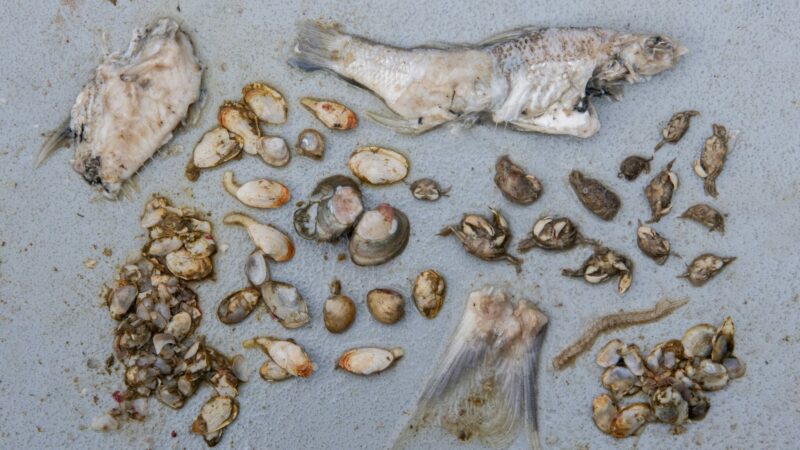The Biggest Sharks Ever Caught
Few fish command as much attention — or generate as much fear — as big sharks. These apex predators are the stuff of legend, both in popular culture and among hardcore fishing circles. From the story of the U.S.S. Indianapolis, a World War II ship that sank in shark-infested waters, through the tale of the Matawan Maneater, which is widely thought to be the inspiration behind the shark in “Jaws,” and all the way up to our present-day obsession with Shark Week, humans have long been captivated by big sharks. This is even more true in the saltwater fishing world, where many anglers dream of landing one of the biggest sharks ever caught on heavy tackle.
Read Next: Charter Captains Say Sharks Are Out of Control and They’re Losing More Fish to the ‘Taxman’
Fishing for sharks has become complicated, though, and harvesting big sharks is not as acceptable now as it was in the 20th century. Shark stocks around the world have been overfished thanks, in part, to the booming black market for shark fins in China and elsewhere. Even though the practice is now illegal in many countries, between 70 and 100 million sharks are “finned” every year and then tossed back into the oceans. These declines have led to protections for many shark species, and shark-killing bans are the main reason why you don’t see many new records for sharks in the International Game Fishing Association’s record books.
This isn’t to say that big sharks aren’t still being caught. Certain species are rebounding in some areas, like the Gulf of Mexico, and this July, a team of Gulf-Coast fishermen competing in a tournament weighed the heaviest bull shark ever recorded in Alabama. Here is a look at some of the biggest sharks ever recorded by the IGFA.
Blacktip Shark (Carcharhinus limbatus)

Blacktips are found worldwide in warm temperate and tropical waters, both inshore and offshore. They can be found near river mouths, in backcountry lagoons, and in deeper water near coral reefs. One of the species that is not considered overfished, these sharks are fast growers and often targeted by inshore anglers. They’ll hit just about any type of live or dead bait and even big saltwater flies. Blacktip sharks now account for approximately 60 percent of commercial and recreational catch of large coastal shark species, according to NOAA Fisheries.
Jurgen Oeder caught his 270-pound 9-ounce blacktip on Sept. 21, 1984, in Kenya’s Malindi Bay. The fish measured 94.46 inches. Oeder was fishing with a Fenwick rod and a Penn International 80 reel loaded with 80-pound Stren line, and using a yellowfin tuna as bait.
Bull Shark (Carcharhinus leucas)
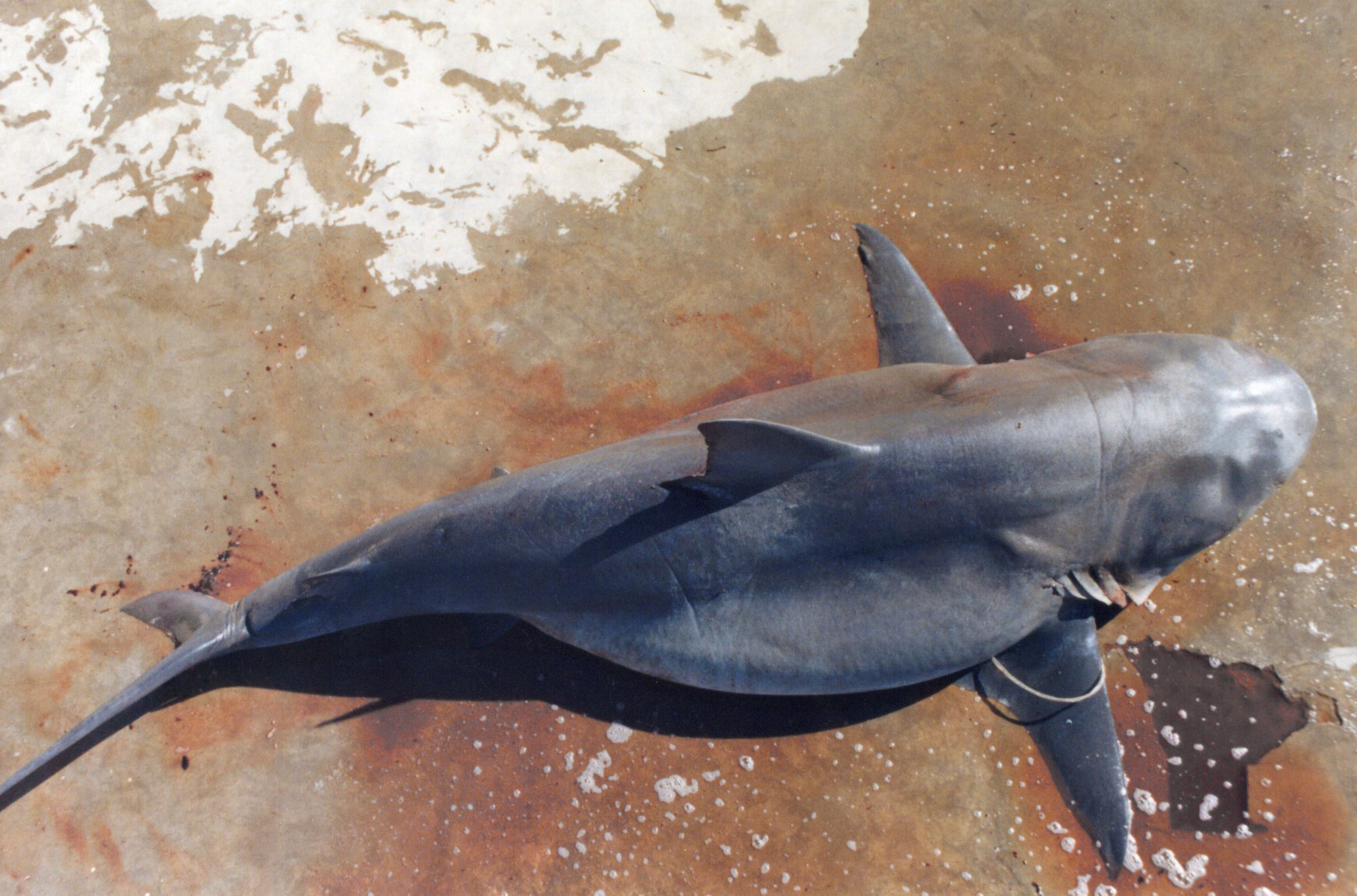
Bull sharks have a reputation for being aggressive, and they’re one of the three species most likely to attack a human when unprovoked. They’re plain looking and stocky in appearance, with small eyes and broad, rounded snouts. While they’re primarily a saltwater fish, bull sharks can live in brackish and freshwater environments too, and they’ve been found miles upriver in many places. These sharks prey on anything they can catch, including smaller fish, other sharks, birds, dolphins, and the occasional mammal.
Ronald de Jager has the current world record for the biggest bull shark. The whopping 697-pound 12-ounce brute taped out at 104.33 inches with a beefy 77.95-inch girth. He also caught his shark in Malindi, Kenya, on March 24, 2001, while trolling a live yellowfin tuna and using a Fenwick rod with a 12/0 Everol reel and 130-pound Hi-Seas Regal line.
Caribbean Reef Shark (Carcharhinus perezii)
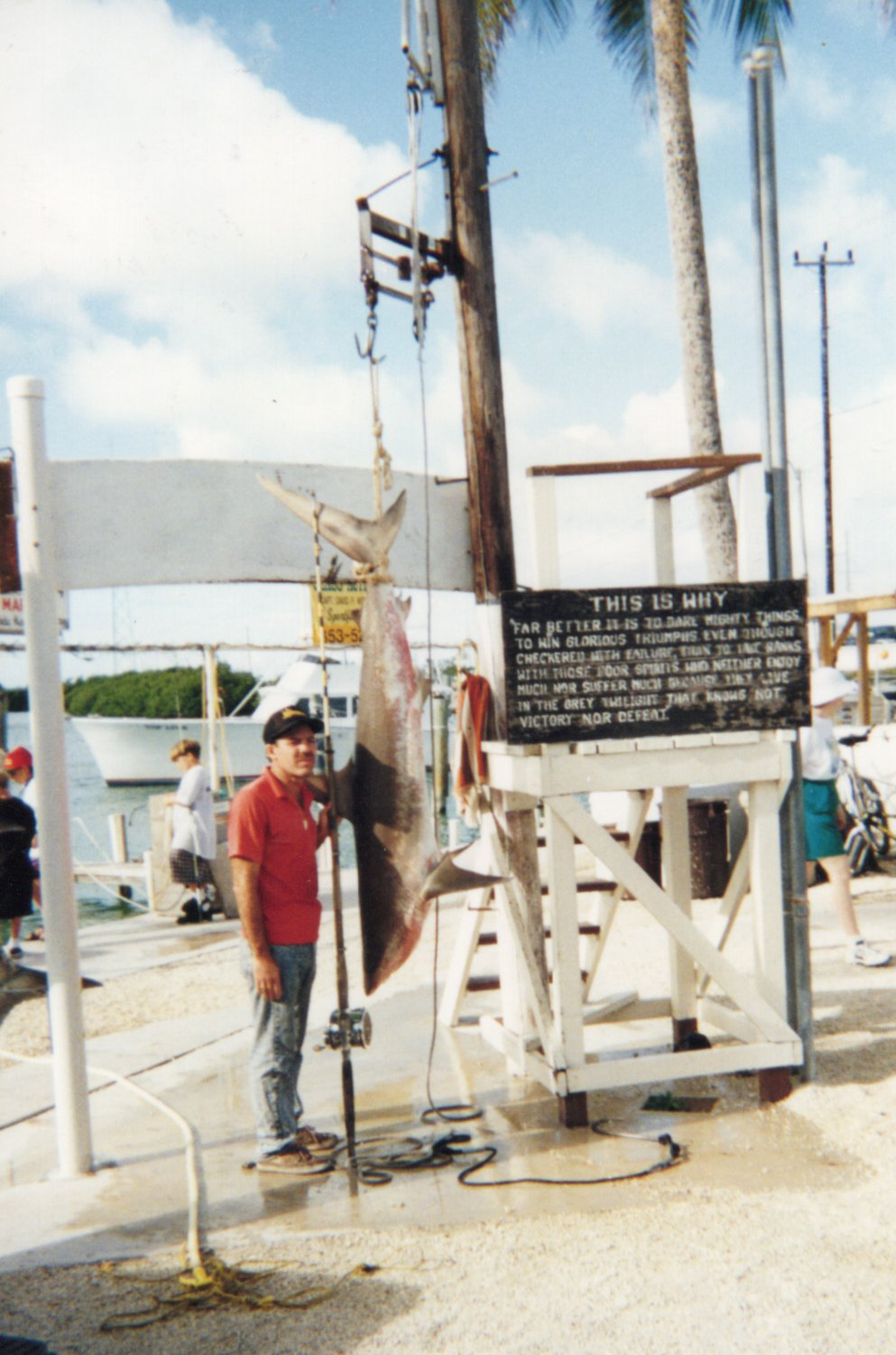
Caribbean reef sharks are similar to bull and dusky sharks, with dark gray to gray-brown backs that fade to a white belly. Their snouts are short and bluntly rounded. Not particularly long-lived, they mature in a few years and have a lifespan of about 14 years or more. They inhabit coral reefs in the Caribbean and off South America and, according to the Florida Fish and Wildlife Commission, they are rarely found north of the Florida Keys. They eat a lot of reef fishes, including barracuda, jacks, snapper, grunts, needlefish, and octopus.
Rene de Dios holds the all-tackle world record with a 154-pounder caught Dec. 9, 1996, at Molasses Reef in Florida. The shark was 54 inches long with a 38.50-inch girth. The angler employed a custom rod with a Penn 12/0 reel spooled with 130-pound Ande line. The bait was a horse eye jack.
Dusky Shark (Carcharhinus obscurus)
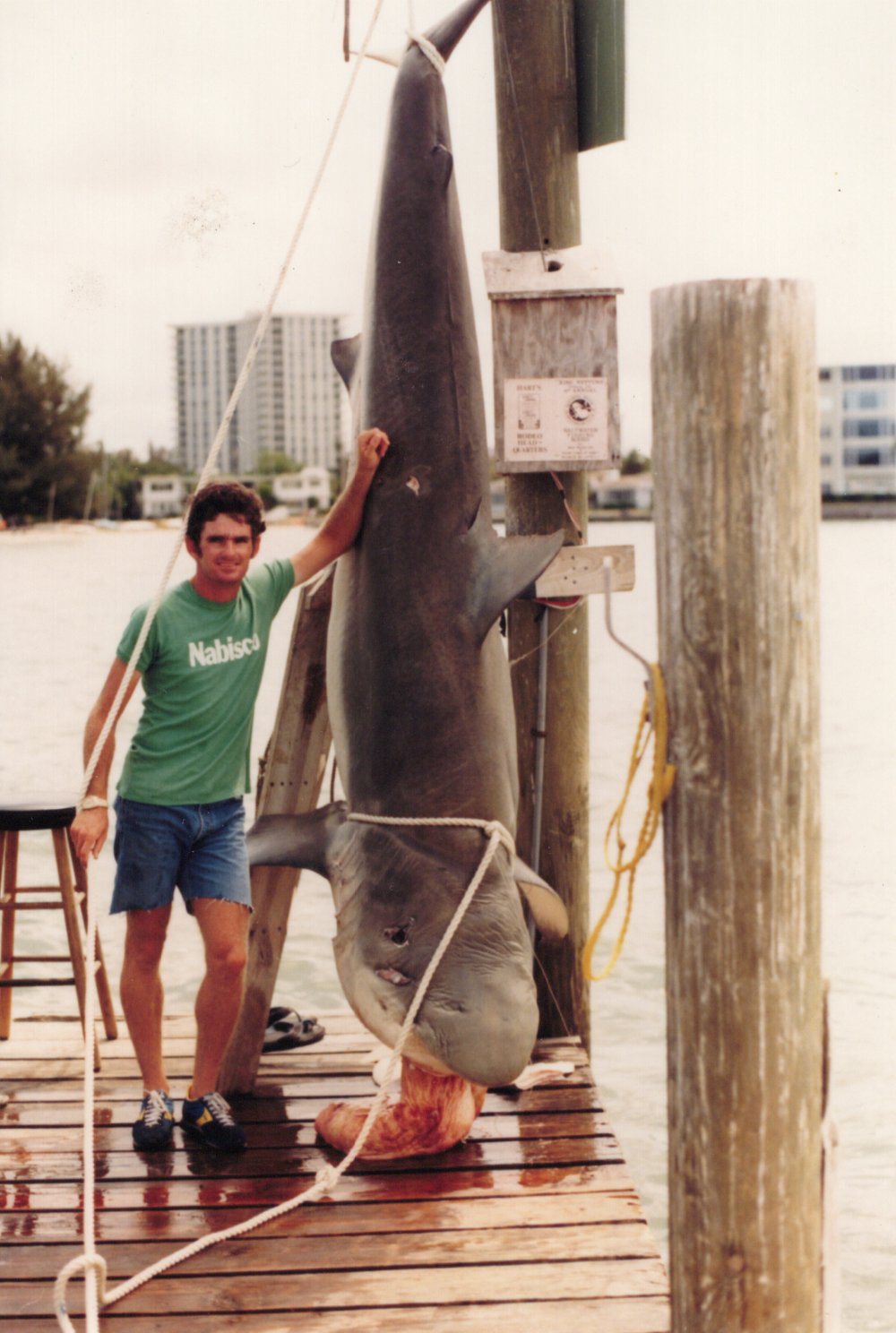
Dusky sharks are wide-ranging and migratory, preferring temperate to tropical waters and ranging from inshore areas to the outer continental shelf. Dusky shark fins are among the most highly prized; the fish are also used for leather and liver oil.
Warren Girle caught the all-tackle world record dusky on May 28, 1982, off Longboat Key, Florida. The shark weighed 764 pounds and was 117 inches long with a 72-inch girth. Girle’s tools included a Fenwick rod, a 9/0 Penn reel, and 130-pound Dacron line. He was drift fishing with a bonito for bait.
Great Hammerhead (Sphyrna mokarran)
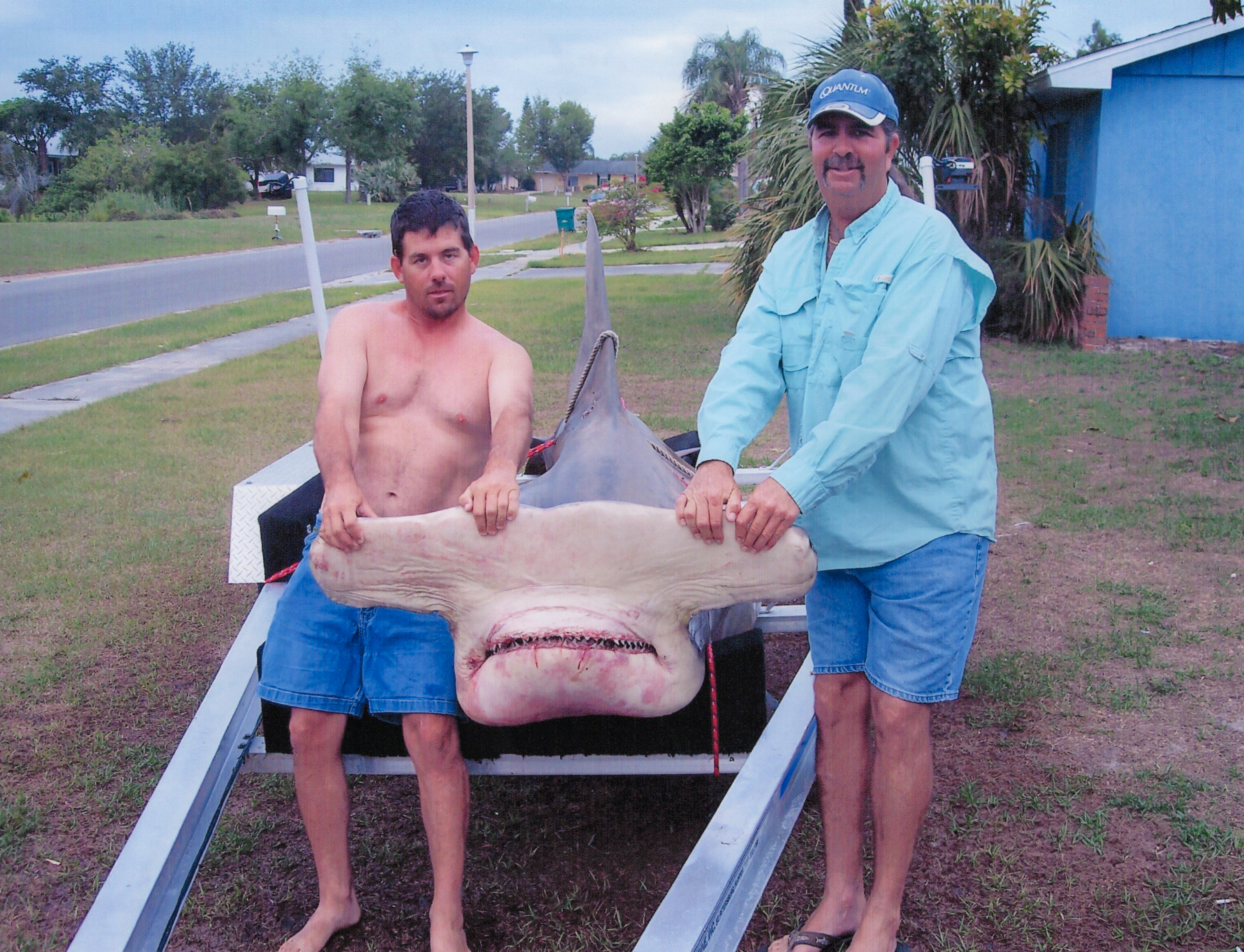
Hammerhead sharks are easily identified by their laterally expanded head, which resembles (you guessed it) a hammer. The great hammerhead shark is the largest of the nine recognized hammerhead species. They can range from coastal waters out to the continental shelves and the adjacent deeper water, but seem to prefer warmer water temperatures.
These sharks have strongly serrated teeth. Stingrays are a favorite prey, and hammerheads use their heads to pin down the rays before killing and eating them. They seem to be immune, or at least indifferent, to stingray venom, as hammerheads have been observed with barbs from the rays’ tails stuck in their mouth.
Bucky Dennis holds the world record for the biggest hammerhead with a 1,280-pound monster he caught on May 23, 2006, off Boca Grande, Florida. This shark was 140 inches long and had a massive 94-inch girth. Dennis was using a custom rod paired with a Penn reel spooled with 100-pound line. He was using a stingray for bait. Dennis’ shark demolished the previous record set by Roberto Estrada, who caught a 357-pound, 8-ounce hammerhead in Pinas Bay, Panama, in 1975.
Lemon Shark (Negaprion brevirostris)
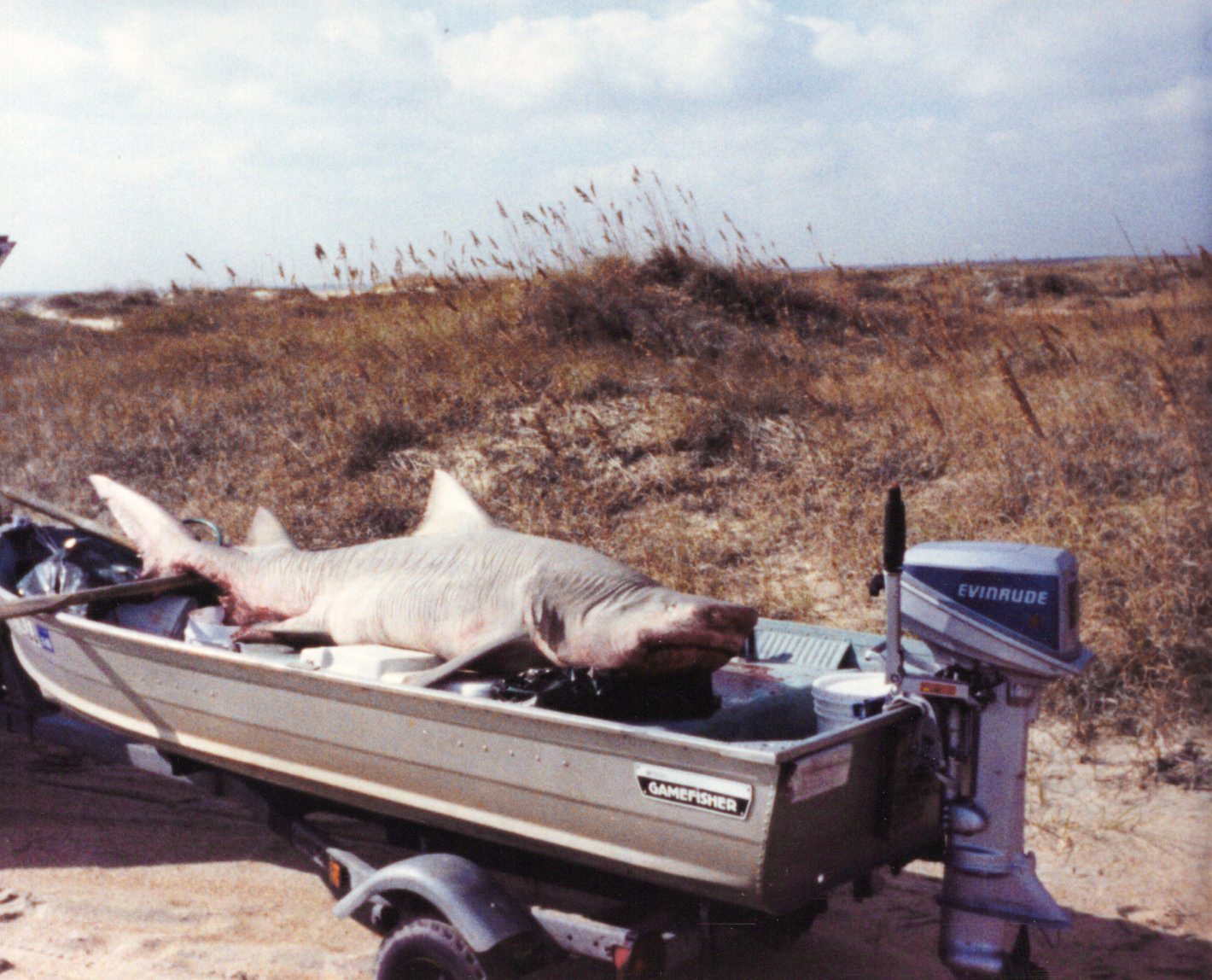
Lemon sharks are easily identified by their two equally sized dorsal fins. They like to forage in sandy inshore areas, places that are also popular with human swimmers and surfers. But, according to the International Shark Attack File, only 10 unprovoked attacks (none fatal) are attributed to lemon sharks, all occurring in Florida and the Caribbean.
Adult lemon sharks average between 8 to 10 feet long. Their range stretches from New Jersey down to Southern Brazil, and into the Gulf of Mexico and Caribbean. They’re also found along Senegal and the Ivory Coast of Africa in the eastern Atlantic. North Pacific lemon sharks range from the Gulf of California and Baja California south to Ecuador.
Colleen Harlow’s 405-pound lemon shark is the all-tackle world record. She caught the 94-inch shark on Nov. 23, 1988, off Buxton, North Carolina. Harlow was using a Penn Senator rod with a 16/0 Penn Senator reel. The line was 80-pound K-Mart. She was bottom fishing and using a bluefish for bait.
Leopard Shark (Triakis semifasciata)

This long, slender shark is found near sandy bottoms of bays and estuaries in the eastern Pacific. Its physical features include black saddle marks on the back and sides, giving it a spotted appearance. It has a short snout, triangular fins, and a notched, asymmetrical caudal (tail) fin.
Most of these sharks, which are typically caught and used for food, are between 20 and 50 inches long, but world-record-holder Maria de la Luz Johnson’s leopard shark measured 64 inches long and weighed 44 pounds, 7 ounces. She caught the shark on Dec. 31, 2011, in California’s San Diego Bay. The gear included a G Loomis rod and an Abu Garcia reel spooled with 20-pound Stren line. Johnson was casting a dead surf perch when the leopard shark bit.
Mako Shark, shortfin (Isurus oxyrinchus)

Makos are found worldwide in tropical and temperate seas. They’re agile, fast, and acrobatic. Hooked makos are a handful, and they’ll roll, dive and leap as high as 30 feet in the air. Stories abound of furious makos jumping into the boat, causing severe injuries to anglers and crew and damage to the cockpit.
Makos are simultaneously beautiful and fearsome, with their back often a brilliant blue gray or cobalt blue with the colors tapering down to a bright white belly. Their huge jaws are filled with curved, razor-sharp teeth. Makos and other “mackerel” sharks such as the white and porbeagle are ovoviviparous, meaning the eggs hatch inside the female and the pups are born alive. Although anglers in the Pacific can still target makos, with a limit of two fish per day and no size limits, landing and keeping Atlantic shortfin makos was banned in 2022.
Read Next: Federal Ban Ends Decades of Mako Shark Fishing Fever in the Northeast
Luke Sweeney caught the world-record mako on July 21, 2001, off Chatham, Massachusetts. The shark weighed 1,221 pounds and was 131.89 inches long. Sweeney fought the fish with a custom Kunnan rod and a Penn 80TW reel. He was drift fishing, with a bonito at the end of the 130-pound Momoi line.
Porbeagle Shark (Lamna nasus)
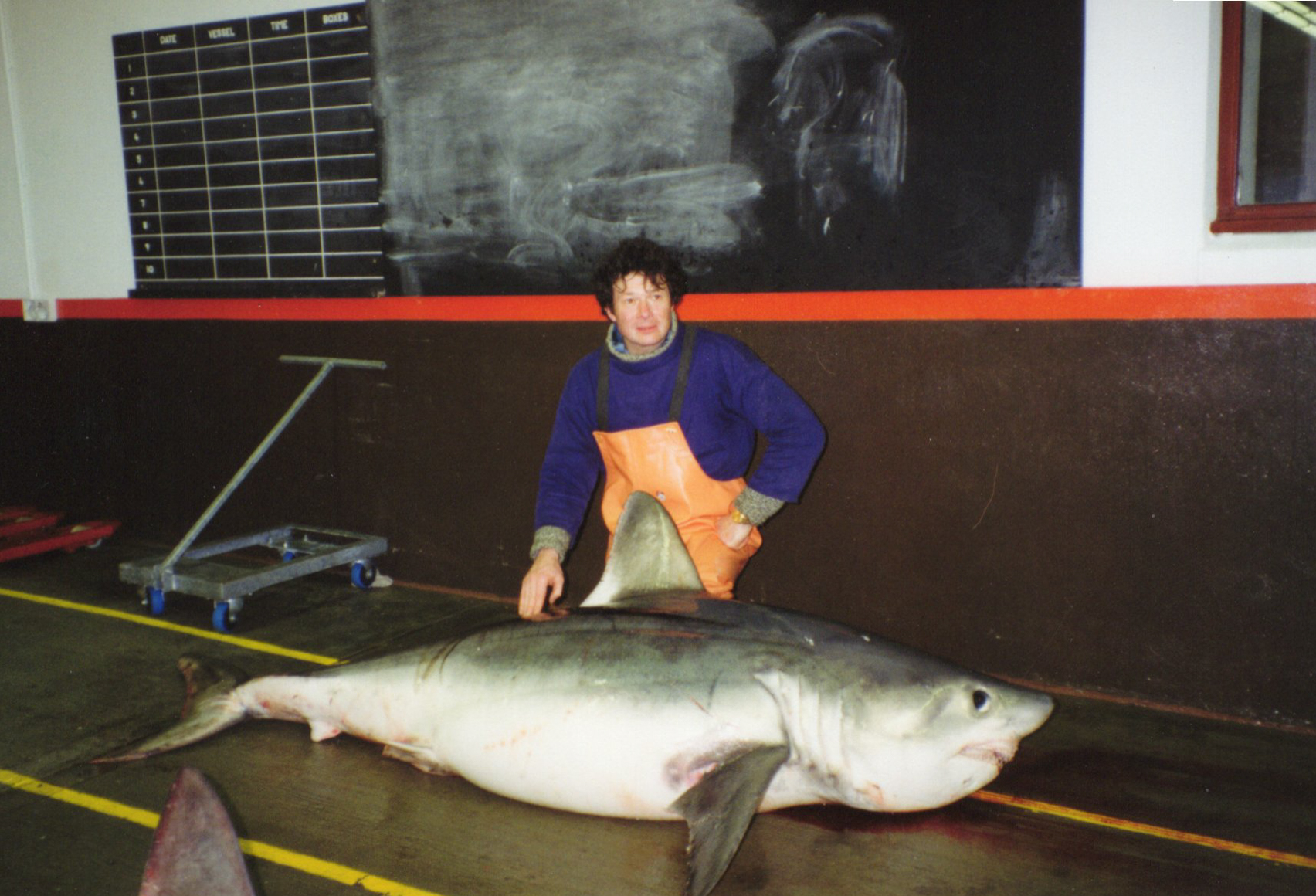
Porbeagles, sometimes called salmon sharks, herring sharks, or bonito sharks, live in temperate Atlantic waters from South Carolina to Newfoundland, as well as in the Pacific Ocean and the Mediterranean Sea. This shark likes to follow its favored prey: schools of mackerel, herring, salmon, cod, and other coldwater species. Porbeagles have a conical snout that ends in a pronounced, almost upturned point. Like makos, porbeagles are known to go airborne when hooked.
The all-tackle world record is held by Christopher Bennett. He caught his porbeagle shark on March 9, 1993, off Pentland Firth in Caithness, Scotland. The shark weighed 230 pounds and measured 98 inches long with an 87-inch girth. Bennett was fishing with a Penn Special Senator D/L rod matched with a Penn 9/0 reel and Berkley 80-pound line. He was using live bait, but the exact type of bait is not listed in the record book.
Sandbar Shark (Carcharhinus plumbeus)
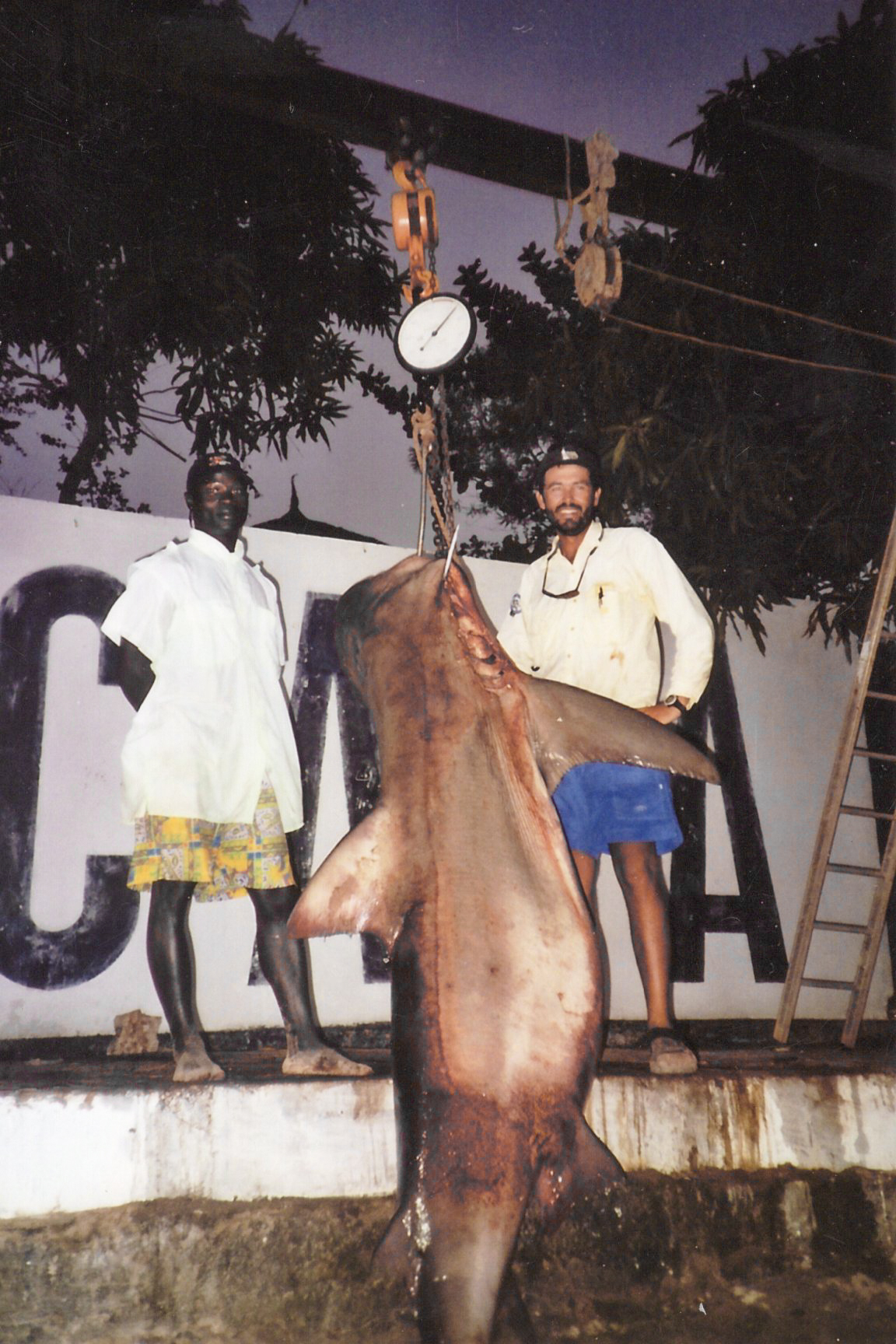
Sandbar sharks are among the largest species found in coastal waters, according to NOAA Fisheries. They like sandy or muddy areas in warm, tropical waters around the world. They are closely related to dusky, bignose, and bull sharks. They have brownish-gray bodies and white bellies, with a tall dorsal fin on their back and large pectoral fins. Their rounded snouts are shorter than most sharks. Sandbar sharks prey on bony fish, smaller sharks, squid, eels, skates, rays, shrimp, and crabs.
Adult sandbar sharks can grow to 8 feet long and weigh as much as 200 pounds, according to NOAA, which makes angler Patrick Sébile’s all-tackle record even more impressive.
Sébile, a noted lure designer, caught his 529-pound, 1-ounce sandbar shark in the Archipelago des Bijagos, Guinea-Bissau on April 5, 2002. The shark was 95.28 inches long with a 70.47-inch girth. Sébile was using a barracuda for bait. His gear included a Sert Stand-Up Power rod, a Gladiator 9/0 reel and 80-pound Asso line.
Sand Tiger Shark (Carcharias taurus)
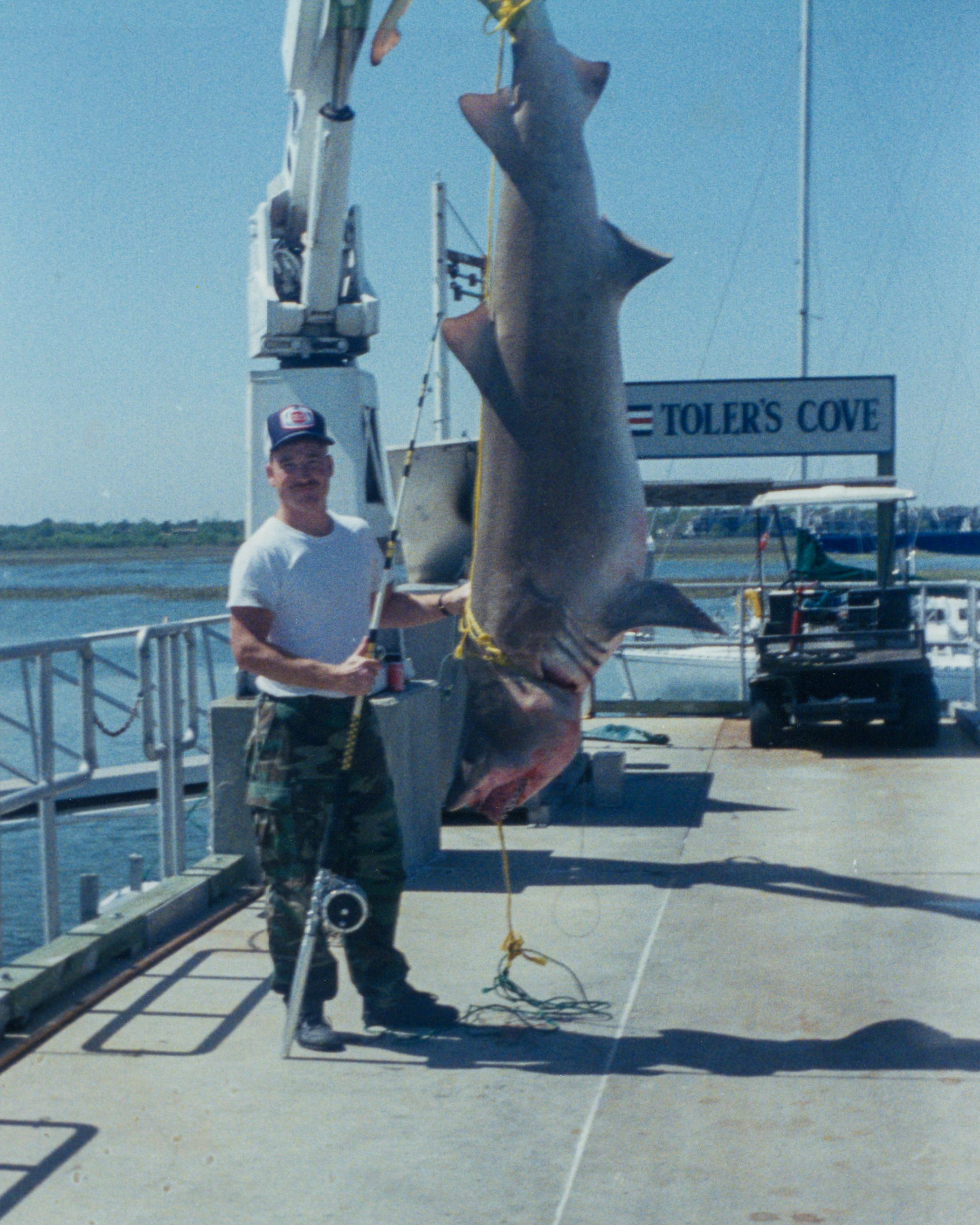
Sand tigers are found in coastal areas in the United States from the Gulf of Maine to Florida and in the northern Gulf of Mexico. They can often be found hanging around shipwrecks off North Carolina, in the area known as the Graveyard of the Atlantic. According to NOAA Fisheries, their rows of jagged teeth belie a largely docile demeanor, and they typically swim calmly around divers. These sharks eat fish such as flounder, skates, monkfish, sea robins, scup, spot, bluefish, butterfish, and tautog.
Mark Thawley caught the all-tackle world record sand tiger shark off the Charleston Jetty in South Carolina on April 29, 1993. The shark weighed 350 pounds, 2 ounces and was 89.37 inches long. Thawley was equipped with a Magnuflex rod and a Penn Senator 9/0 reel. The line was 80-pound Ande. He was bottom fishing but the type of bait he used is not specified in the records.
Thresher Shark (Alopias spp.)
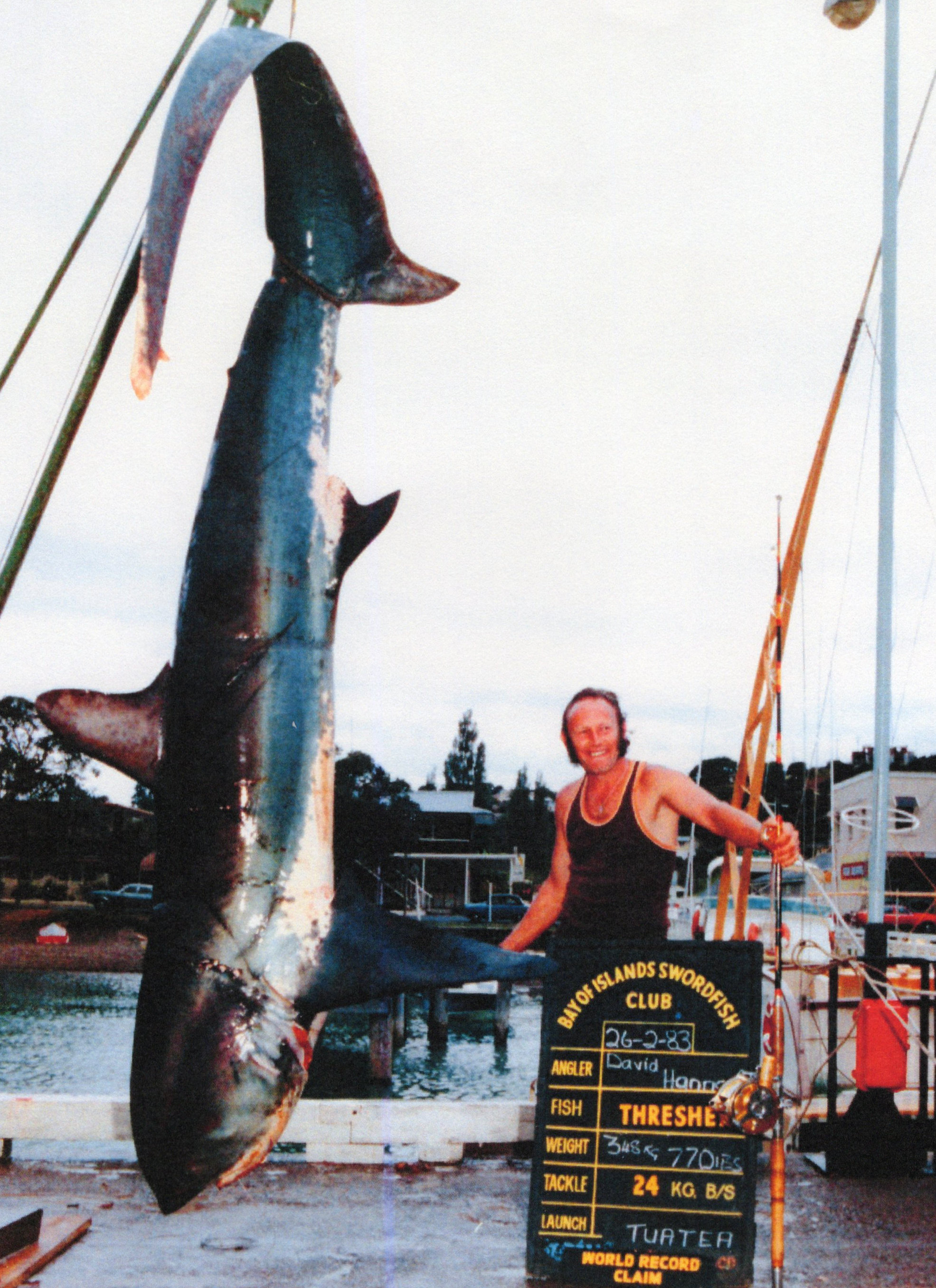
There are a variety of thresher sharks: pelagic, Pacific, Atlantic, and longtail. The upper part of the tails on threshers, especially the aptly named longtails, are distinctive and long. (With longtails, the upper lobes of their tails can stretch as long as the rest of the entire fish.) Threshers are generally found offshore but will occasionally show themselves in inshore waters.
Thresher sharks use their long tails to slap or “thrash” or their prey. They’ll often herd bait fish into a tight ball and then use their powerful tails to stun or injure them before consuming them. This “tail first” approach is why anglers often hook these sharks in the tail. Trolling or drifting are typical fishing methods. Although most anglers use live or cut bait, the same artificial lures used for tuna and marlin can also work.
The biggest recorded thresher was caught on Feb. 26, 1993, in the Bay of Islands, New Zealand by D.L. Hannah. The shark weighed 767 pounds, 3 ounces, was 112.59 inches long and sported a 55.90-inch girth. Hannah was using a Tasma rod with a Penn International 80 reel. The reel was spooled with 59-pound Amalon T line. Hannah was tolling a kahawai, also known as an Australian salmon.
Tiger Shark (Galeocerdo cuvier)
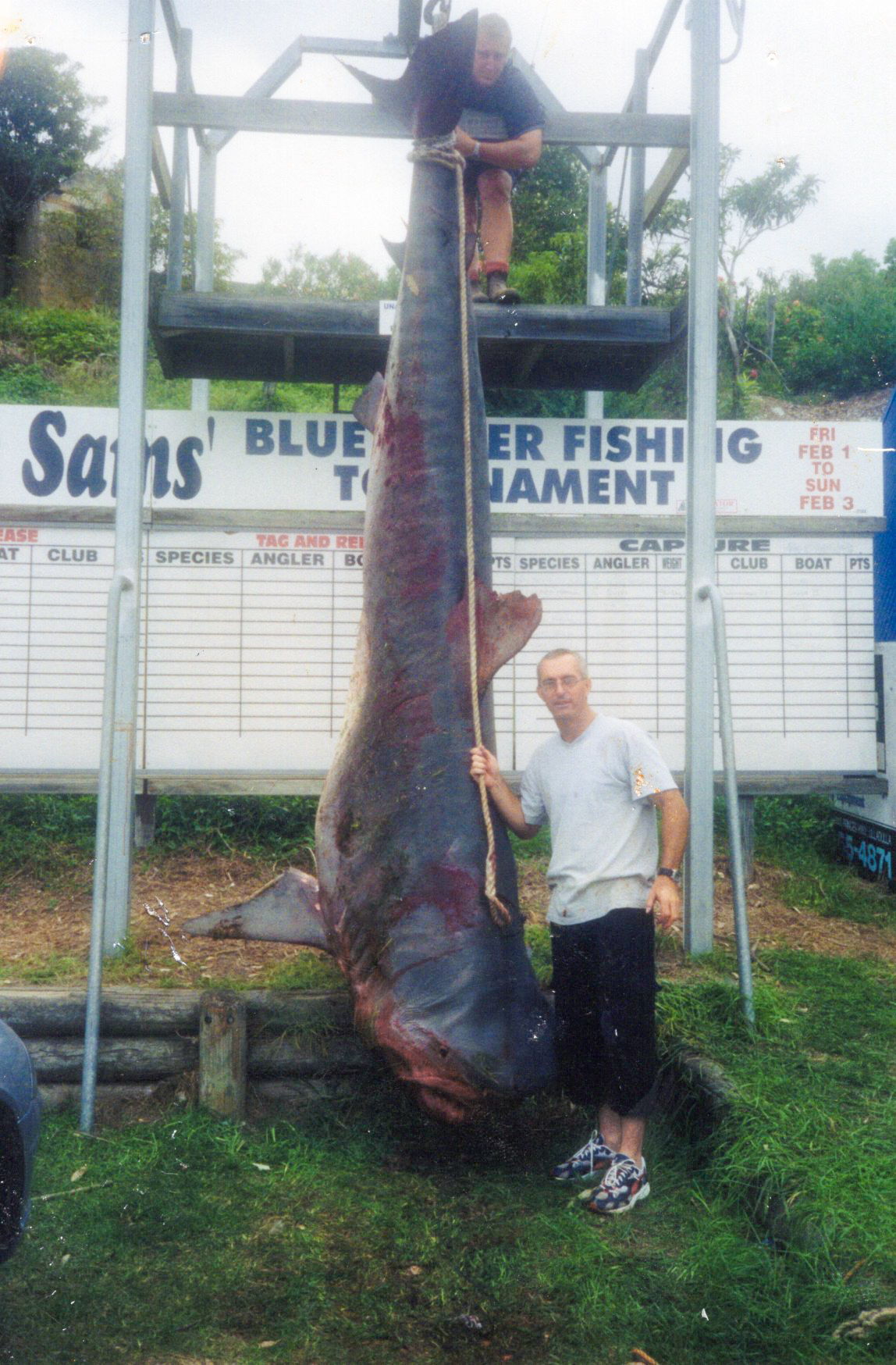
Tiger sharks are a widely distributed and far roaming species that can be found worldwide in tropical and warm seas. They have an impressive set of chompers lining their huge mouths, with 48 identical serrated teeth, uniquely designed for both cutting and sawing, located in rows on the upper and lower jaws.
Tiger sharks are among the most dangerous fish to humans, and they’re second only to white sharks in terms of the number of recorded attacks (statistically speaking, however, shark attacks are still quite rare). They regularly hunt in shallow waters were people swim, and they’ve been implicated in several fatal attacks in Australia, Florida, and Hawaii. Favored fishing methods include live bait fishing while chumming from boats or trolling.
The all-tackle record is held by Kevin James Clapson, who caught a 1,785 pound, 11-ounce tiger off Ulladulla, Australia, on March 28, 2004. The shark was 142.52 inches long with a 110.24-inch girth. Clapson was fishing with a Beastmaster rod and Penn 80TS reel. The line was 37-kilogram (81-pound) Tortue. He was drift fishing, but the type of bait he used isn’t specified in the records.
The all-tackle close second tiger shark was caught June 4, 1964, while fishing off a pier in Cherry Grove, South Carolina, by angler Walter Maxwell. This fish weighed 1,780 pounds and was 166.5 inches long with a 103-inch girth. Maxwell was using a custom-built rod with a Penn Senator reel spooled with 130-pound Ashaway line. He was using a skate for bait.
White Shark (Carcharodon carcharias)
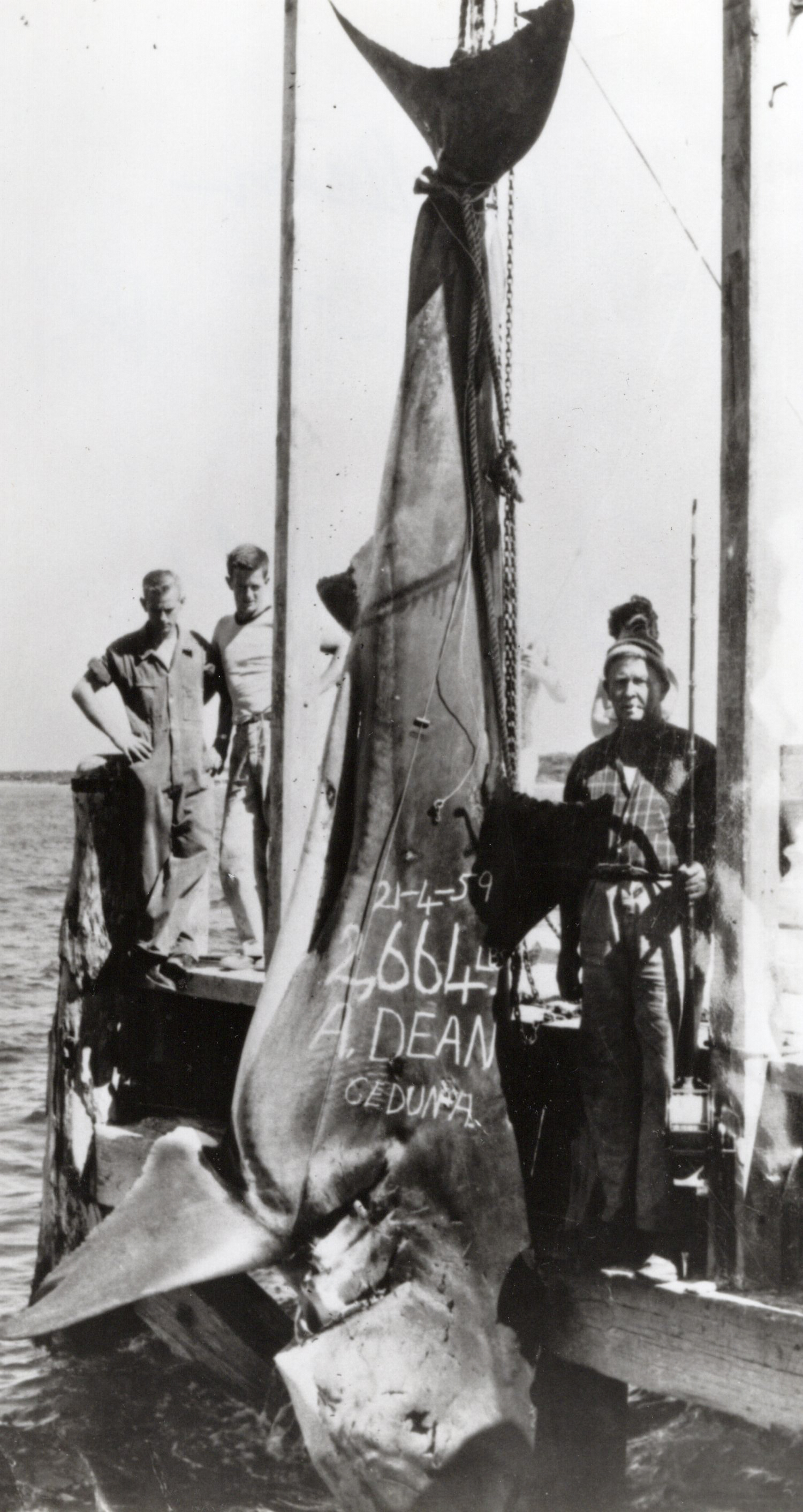
Known by most as the great white shark, this fish has kept more people out of the water than any other species and is the star villain in the 1975 classic, “Jaws.” It is considered one of the most powerful predators in the world. These sharks are routinely found in cooler, temperate coastal waters where abundant food is located. This includes much of the United States coast along with Chile, northern Japan, southern Australia, New Zealand, and southern Africa. Telemetry tracking shows some individual white sharks travel far and wide as they roam the oceans, but they typically return annually to their temperate feeding grounds.
Read Next: The Ultimate Guide to Great White Shark Attacks
The IGFA points out that one way white sharks differ from other shark species are by their teeth, which are described as, “large and triangular like stone arrowheads, with sharp, serrated cutting edges.” Only the belly on a white shark is white. The top and sides are grayish brown and they can grow to longer than 20 feet. (Yes, you’ll need a bigger boat.)
They eat fish, squid, other sharks, sea turtles, seals, sea lions, and seagulls. They’ve also been known to attack swimmers and surfers, often mistaking them for seals or other prey. When irritated, they’ve also been known to attack boats, sinking the small ones on occasion and shaking larger boats. The IGFA calls the white shark “ the most dangerous of all sharks as far as size, strength, ability and disposition to attack are concerned.”
Angler Alfred Dean holds the all-tackle world record for white sharks, with a beast that weighed more than a ton. (2,664 pounds to be exact.) The shark was 16 feet, 8 inches long and had a girth of 114 inches. He caught the shark on April 21, 1959, off Ceduna, Australia. Dean was using a fiberglass rod with a Penn 14/0 reel and 130-pound Ashaway line. He was using a porpoise for bait. Great whites are now a prohibited species to target in the U.S. and they’re protected internationally, which means they must be released immediately if accidentally caught.
FAQs
Whale sharks are far and away the biggest member of the shark family. (This also makes them the biggest fish of any kind.) They can grow more than 60 feet long, and the heaviest whale shark ever recorded was reportedly caught in Taiwan in 1985. It weighed 34 metric tons or nearly 75,000 pounds. Because whale sharks are filter feeders that eat primarily plankton, they’re almost never caught by anglers using traditional tackle.
The largest shark ever caught on a rod-and-reel and confirmed by the IGFA is the white shark listed above. Alfred Dean’s 2,664-pound white shark also takes the No. 1 spot in a list of the biggest fish ever caught, and it’ll likely remain there for some time. Great white sharks are now federally protected in U.S. waters, and it’s illegal to harvest them in many other places around the world, which means they’re no longer accepted by the IGFA as potential records.
“Deep Blue” is a female white shark that is thought to be the largest great white ever recorded. The giant shark has been featured in Shark Week, and it was first photographed off the coast of Mexico by a marine researcher. Although there are no exact measurements for “Deep Blue,” it’s estimated that the shark is at least 20 feet long and 2.5 tons. The shark was last seen in 2019, and experts believe that if it is still alive, it would be around 60 years old.
Final Thoughts on the Biggest Sharks Ever Caught
Humans, and especially fishermen, have long been obsessed with big sharks. But due to population declines and overfishing, it’s now illegal to harvest many shark species around the world, which means there aren’t as many records being submitted as there were during the 20th century. Big sharks are still being caught, however, and in some areas, their populations are rebounding.
The post The Biggest Sharks Ever Caught appeared first on Outdoor Life.
Source: https://www.outdoorlife.com/fishing/biggest-sharks-ever-caught/



